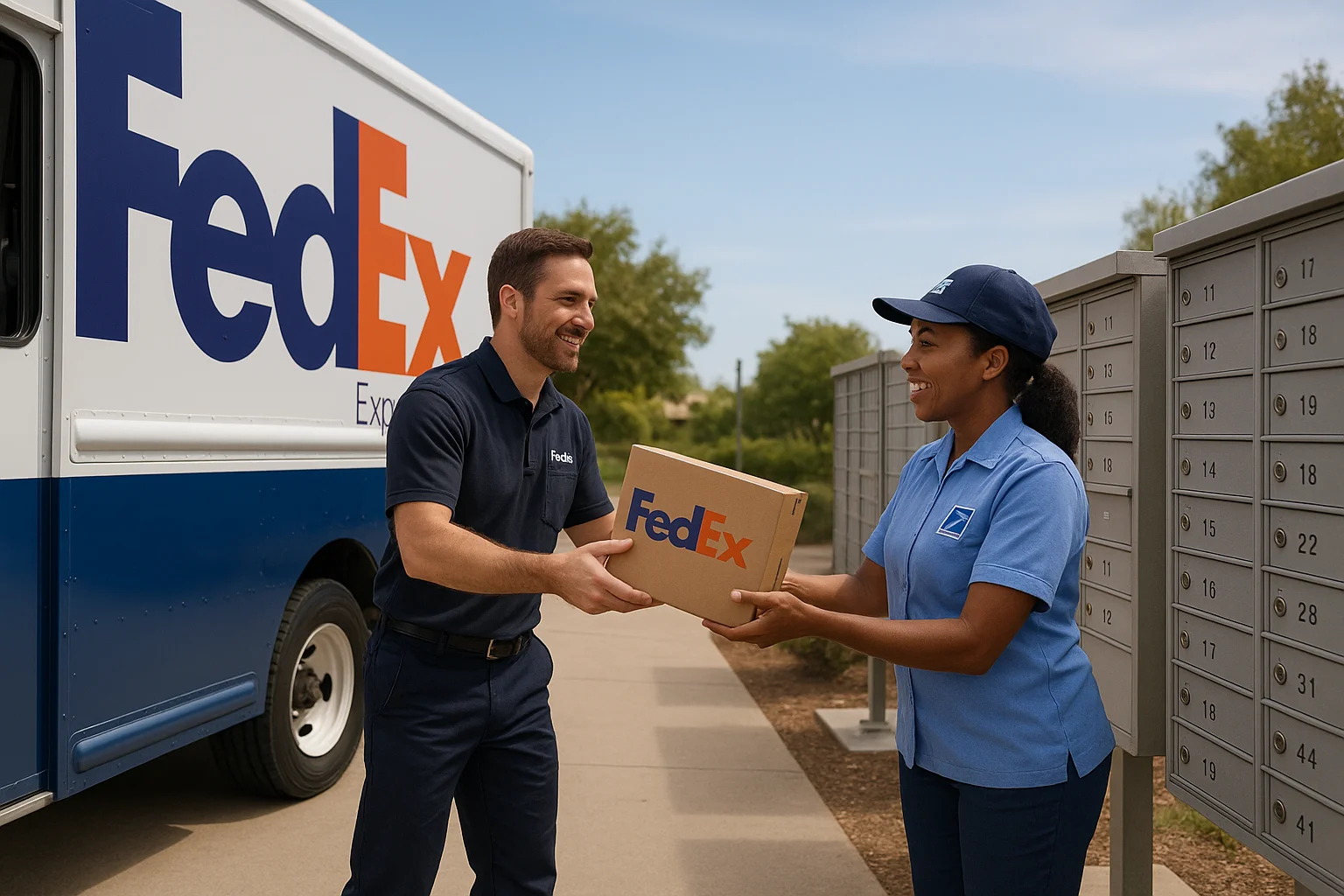FedEx generally requires a physical street address for delivery and does not deliver directly to U.S. Postal Service (USPS) P.O. boxes under its standard services (FedEx Ground, FedEx Express, FedEx Home Delivery, etc.). However, FedEx offers solutions-most notably FedEx SmartPost-that leverage the USPS network to reach P.O. boxes. This guide explains:
- Why most FedEx services cannot ship to P.O. boxes
- How FedEx SmartPost works to deliver to P.O. boxes
- Labeling and addressing requirements
- Alternative options and workarounds
- Costs, transit times, and service comparisons
- Best practices for shippers
By understanding these facets, shippers can choose the service that aligns with their customers’ needs and delivery requirements.
1. Standard FedEx Services and P.O. Boxes
1.1 Physical-Address Requirement
FedEx’s core services (FedEx Priority Overnight®, FedEx 2Day®, FedEx Express Saver®, FedEx Ground®, FedEx Home Delivery®) are ground or air carriers that rely on FedEx’s own delivery network. These services require a physical street address for every shipment. Addressing a package to a P.O. box under these services typically results in:
- Shipment being returned to sender
- Package held at the local FedEx facility until a valid street address is provided
- Delay, extra fees, or refusal of delivery
1.2 Why P.O. Boxes Are Incompatible with FedEx’s Network
The primary reasons FedEx does not deliver standard shipments to P.O. boxes include:
- FedEx’s proprietary tracking and routing is optimized around street-level delivery points, not USPS box locations.
- Security and access constraints: Many P.O. box facilities are only accessible by USPS carriers.
- Contractual limitations: FedEx’s service agreements with customers and carriers stipulate street delivery.
2. FedEx SmartPost: Bridging FedEx and USPS
2.1 What Is FedEx SmartPost?
FedEx SmartPost (now marketed as FedEx Ground Economy) is a collaborative service where FedEx handles the initial “first-mile” pickup and sorting. The final “last-mile” delivery is performed by the USPS, enabling access to:
- P.O. boxes
- Military (APO/FPO) addresses
- U.S. territories
2.2 How FedEx SmartPost Works
- Pickup and aggregation
- Shipper schedules a FedEx pickup.
- Packages are transported to a FedEx facility and sorted.
- Transfer to USPS
- At a regional hub, FedEx loads SmartPost parcels onto USPS-bound pallets.
- Shipments are transferred to USPS with USPS tracking-compatible barcodes.
- Last-mile delivery
- USPS carriers deliver to street addresses, curbside mailboxes, and P.O. boxes.
This hybrid model leverages FedEx’s transport network efficiency and USPS’s ubiquitous mail-delivery infrastructure.
2.3 Benefits and Limitations of SmartPost
Benefits:
- Delivery to P.O. boxes and military addresses.
- Cost-effective (leverages USPS’s lower-cost last-mile rates).
- Retailer integration: Many e-commerce platforms automatically choose SmartPost for P.O. box recipients.
Limitations:
- Longer transit times (typically 2–7 business days).
- Limited tracking granularity once USPS takes over; updates may only show “Accepted at USPS” and “Delivered.”
- Weight restrictions: Packages typically must weigh under 70 lbs and be under 108″ in combined length and girth.
3. Addressing and Labeling Requirements
3.1 Format for Shipping to P.O. Boxes Using SmartPost
To ensure smooth processing and delivery, adhere to USPS addressing standards on FedEx labels:
Recipient Name P.O. Box 1234 CITY, STATE ZIP+4
- Enter “P.O. Box” exactly. Avoid abbreviations like “POB” or “Box.”
- Include the ZIP+4 code for precise sorting and timely delivery.
- Use the FedEx shipping system or online label tool and select “FedEx SmartPost” (Ground Economy) as the service.
3.2 Common Pitfalls and How to Avoid Them
- Wrong service selected: Manually verify SmartPost, not Ground or Home Delivery.
- Incomplete ZIP codes: Always include ZIP+4 to reduce misrouting.
- Address clutter: Remove apartment or suite references when shipping to a box.
- Automated returns: FedEx’s system rejects non-physical addresses for standard services.
4. Alternative Delivery Options
4.1 Ship to a Local FedEx Office or Access Point
For customers with P.O. boxes but needing expedited FedEx service, you can:
- Ship to a FedEx Office™ retail location or authorized FedEx Ship Center.
- Select “Hold at Location” on FedEx’s label options.
- Recipients retrieve packages with government-issued ID.
4.2 Ship to a Physical Address of a Third-Party Locker
Partners like The UPS Store®, Walgreens®, or Kinko’s sometimes serve as pickup points for FedEx shipments. These partners have street addresses and secure lockers, enabling:
- Flexibility for recipients without a street address.
- Extended hours and additional convenience.
4.3 Consolidation Services and Virtual Mailboxes
Services such as VirtualPostMail, Shipito, and MyUS provide:
- A physical street address for package receipt.
- Repacking and forwarding to P.O. boxes or international addresses.
These are ideal for users who frequently receive packages from carriers that do not serve P.O. boxes.
5. Costs, Transit Times, and Comparisons
| Service | Delivery to P.O. Box | Typical Transit Time | Cost Tier |
|---|---|---|---|
| FedEx Express/SameDay | No | Overnight to same day | High |
| FedEx Priority Overnight® | No | Next-business-day morning | Very High |
| FedEx 2Day® | No | 2 business days | High |
| FedEx Ground/Home Delivery® | No | 1–5 business days (USPS transfer) | Medium |
| FedEx SmartPost/Ground Economy | Yes | 2–7 business days | Low |
- SmartPost is the sole FedEx-branded method to reach P.O. boxes without third-party intervention.
- Expedited FedEx services must reroute via a physical point if P.O. box delivery is required.
6. Best Practices for Shippers
- Identify the recipient’s address type up front.
- Automate address validation to detect P.O. boxes.
- Offer SmartPost selection or alternate service suggestions on checkout.
- Select the appropriate FedEx service.
- For cost savings and P.O. boxes, default to SmartPost/Ground Economy.
- For speed, suggest street addresses or FedEx Access Points.
- Maintain clean address data.
- Use USPS Address Verification APIs or FedEx Address Validation.
- Enforce ZIP+4 usage for all P.O. boxes.
- Communicate transit expectations.
- Clearly state that SmartPost shipments typically take longer.
- Provide USPS tracking URLs post-handover.
- Offer multiple delivery options.
- Include FedEx Offices, lockers, or retail partners in shipping choices.
- Consider virtual mailbox services for digital-first customers.
Conclusion
FedEx’s direct-to-door services do not support P.O. box deliveries; however, shippers can use FedEx SmartPost (Ground Economy) or alternative pickup points to reach recipients who rely on P.O. boxes. By understanding service capabilities, properly formatting addresses, and offering a range of delivery options, businesses can ensure reliable, cost-effective shipments to all customers-including those with P.O. box addresses.



Leave a Reply